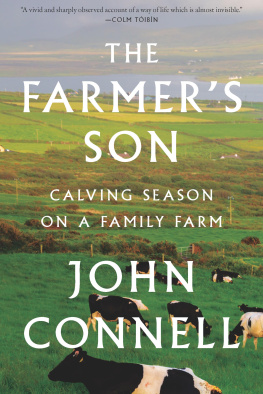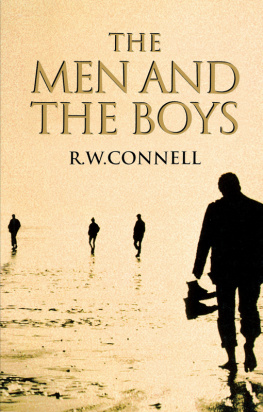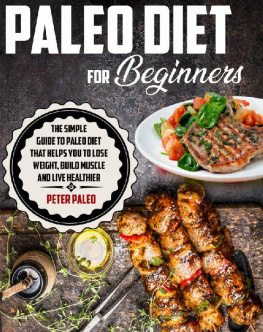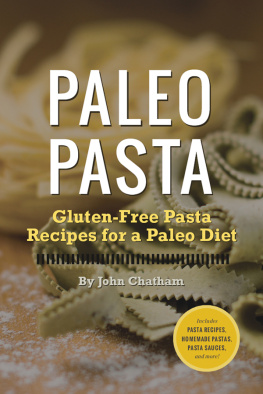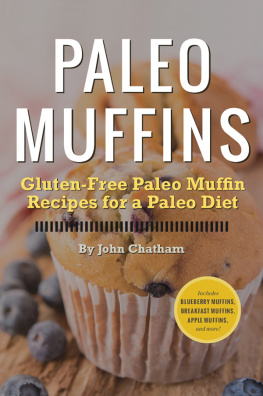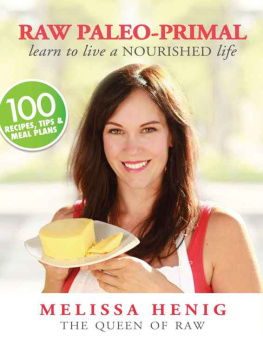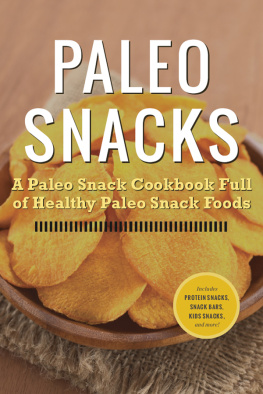POWERFUL
PALEO
SUPERFOODS
THE BEST PRIMAL-FRIENDLY FOODS FOR BURNING FAT, BUILDING MUSCLE AND OPTIMAL HEALTH

HEATHER CONNELL, R.H.N.C.
AUTHOR OF PALEO SWEETS & TREATS
WITH JULIA MARANAN
2014 Fair Winds Press
Text 2014 Heather Connell and Julia Maranan
Photography 2014 Heather Connell
First published in the USA in 2014 by
Fair Winds Press, a member of
Quayside Publishing Group
100 Cummings Center
Suite 406-L
Beverly, MA 01915-6101
www.fairwindspress.com
Visit www.QuarrySPOON.com and help us celebrate food and culture one spoonful at a time!
All rights reserved. No part of this book may be reproduced or utilized, in any form or by any means, electronic or mechanical, without prior permission in writing from the publisher.
Digital edition published in 2014
Digital edition: 978-1-62788-015-2
Softcover edition: 978-1-59233-597-8
Library of Congress Cataloging-in-Publication Data available
Cover design by Duckie Designs
Book design by Duckie Designs
Book layout by meganjonesdesign.com
Photography by Heather Connell
Images courtesy of
The information in this book is for educational purposes only. It is not intended to replace the advice of a physician or medical practitioner. Please see your health care provider before beginning any new health program.
To Scott, Clair, and Laine, who are the loves of
my life and bring so much happiness to my day.
Heather
To Dan and Joshua, who make every day
better than I could have asked for or imagined.
Julia
CONTENTS
INTRODUCTION
THE BASICS OF EATING PALEO
My Paleo life started in 2011. I had been suffering for several months with health issues, which led to doctor visit after doctor visit with no answers. I was frustrated. I was tired. I was madand I needed to make changes. But what did I need to change, and where did I need to start? I started with my diet, and its there where I found the culpritsgluten, dairy, and soy. Within forty days of switching my diet to a Paleo lifestyle, the health issues that had been a constant presence simply disappeared.
In my journey living a Paleo lifestyle these past few years, I have not only transformed my health, but I have also come to appreciate and love REAL FOOD. At its heart, Paleo is about eating foods that are REAL, or as I like to explain to my kids, the superheroes of the food world. I believe that if you can find food grown in naturally nutrient-rich soil (or meat from animals fed their natural diets), you are pretty much guaranteed to have the right balance of vitamins and minerals to not just survive, but thrive. After studying nutritional science, I understand why certain foods that are often overlooked or rejected by health experts, such as coconut oil and grass-fed beef, actually qualify as superfoods in the Paleo community, and why they deserve a place at your table. Now its my turn to share with you the whys. Its my hope that this book will help you incorporate Paleo superfoods into your diet so you can feel your best, too.
WHAT IS PALEO?
The Paleo (or, Paleolithic) diet is a lifestyle based on the ancestral human diet. The Paleo diet (or lifestyle) has been called many things: Caveman Diet, Primal Diet, Real Food Diet, even MVF, which stands for Meat-Vegetables-Fat. All these terms refer to basically the same way of eatingthe eating habits of our hunter-gatherer Paleolithic ancestors who, if they were able to avoid illness (due to the lack of modern medicine), lived very long and healthy lives.
Although we cant know exactly what our hunter-gatherer ancestors ate, in principle, Paleo is about eating the same whole foods that were found in nature millions of years ago. These include foods that come from the land, such as meats, vegetables, fruits, nuts, and seeds, and foods that come from open waters, such as fish and shellfish. These foods are nutrient-dense and are free from all those modern ingredients you cant pronounce. When we remove inflammatory foods from our dietfoods that were not part of our ancestors daily meals, such as wheat flour, industrial seed oils, sugar, and even supposedly healthy foods such as grains, dairy, and soywe reduce the risk of the most prevalent diseases of our civilization: heart disease, cancer, obesity, autoimmune diseases, and diabetes. Additionally (and best of all), we feel better, our energy levels rise, we look years younger, and we sleep better.
WHAT CAN YOU EAT ON THE PALEO DIET?
HERE IS THE YES LIST, OR WHAT I LIKE TO CALL THE REAL FOOD LIST
First, eat whole foods! Beyond that, the idea is to rely on foods that our hunter-gatherer forbears ate because our bodies are particularly well designed to digest them and to use the nutrients they offer. Here is a short rundown of those foods and why they make the Paleo YES list. The rest of the book focuses on Paleo superfoods within each category that are your absolute best choices.
MEATS AND EGGS: Although conventional dietary advice recommends limiting animal products, a look into their nutritional profiles will quickly show you that these foods are incredibly concentrated sources of many nutrients, including vitamin B12, zinc, and iron. They also provide complete protein, which means they contain all of the amino acids required by the body. Not that all animal foods are created equalread on to find out which ones earn the title of superfood (and why your meats and eggs should always come from grass- and organic-fed, pastured-raised, and sustainable sources).

SEAFOOD AND SHELLFISH: These foods are excellent sources of protein and rich omega-3 fatty acids, plus vitamins and minerals. As such, theyre an important component of a balanced Paleo diet that includes high-quality animal products. Seafood consumption has been linked to a reduced risk of many diseases, which we will talk about more specifically in the chapters ahead. Wild-caught seafood and shellfish are your best bet.
VEGETABLES: A slew of scientific studies have shown the incredible benefits of the health-promoting nutrients in vegetables. While many other diets prominently feature vegetables, there are several that are particularly important to the Paleo lifestyle. Those superfoods are the ones well focus on here. There is an abundance of vegetables from season to season, which gives you no excuse not to include one (or two) on your plate all year-round. Frozen organic vegetables are also an option since they are usually flash frozen right after harvesting, preserving their nutrients. Make sure the variety you choose doesnt have any other additives, such as salt.
FRUITS: These flavorful, refreshing gems are full of healthful nutrients. Modern fruits may be larger and sweeterthus, containing more fructosethan in centuries past, so I recommend eating lower-sugar fruits like many of the ones listed in this book. Choose in-season and locally grown fruits for the best taste and the most nutrients. Frozen organic fruits are fine as well, just read the label to make sure there are no added sugars.


